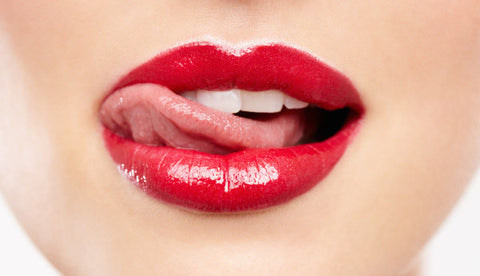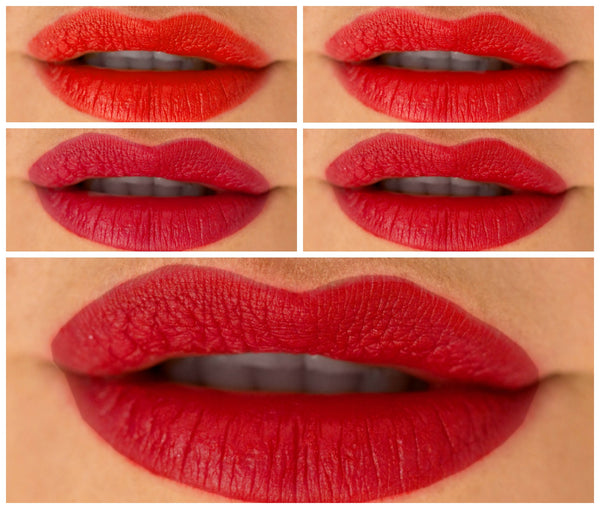A few years back, there was a whole lot of internet chit-chatter about how much lipstick a woman eats in her lifetime (one source claims its 7 pounds!). Now while those claims remain unfounded, there's no denying that what we put on our bodies is akin to what we put in our bodies- and you want to be making sure it's as close to nature as possible.

So what's in a standard red lipstick (and what makes Dusk by Adele so different)?
Beeswax
Used to harden products, it's not necessarily an ingredient that causes harm to our bodies- but is causing environmental issues (watch The Vanishing of the Bees)and brings up ethical issues of the use of animal products.
Lanolin
Again, not necessarily harmful to humans, but have you ever stopped to wonder what lanolin actually is?
You know when you don't wash your hair for a few days, and it becomes greasy and oily? Now imagine a sheep, that hasn't had a wash for a year, and has then had the oil squeezed from it's shorn wool... and then imagine putting that on your lips.
Gross, hey?
Cochineal bugs
Cochineals are harvested mainly in Peru and the Canary Islands on plantations of prickly pear cacti, the bugs' preferred host. Sun dried, squashed and dipped in an acidic solution, carminic acid from the bodies is used as red dye.
No thanks!
Methylparaben is a preservative used in many beauty products- at least in the U.S. Use of these chemicals is restricted in Europe because they've been linked to cancer, may disrupt the endocrine system, or be toxic in other ways. The EWG Cosmetics Database labels them a "high hazard."
Propylparaben is a frequently used cosmetics ingredient that can irritate skin and eyes or cause reactions in those who are allergic. Some studies have also raised concerns about endocrine disruption, cancer and other toxic effects. It is rated a "moderate hazard" by the EWG.
Retinyl Palmitate is a synthetic form of vitamin A that may be toxic to pregnant women. It is rated a "moderate hazard" by the EWG because limited evidence links exposure to a range of health problems, from cancer to reproductive effects.
Tocopheryl Acetate, also known as vitamin E acetate, is used in a variety of products, including lipstick, moisturizer and foundation. The EWG rates it as a "moderate hazard" because it may cause itching, burning, scaling, hives and skin blistering, and may be toxic.
So what do we use?

I am so proud of our beautiful, vegan, palm oil free, cruelty free plant based formulation! Filled with natural, organic (where possible) and body friendly ingredients, I know you'll love them as much as I do.
Ricinus Communis Seed Oil* (Castor)
Castor oil is a vegetable oil obtained by pressing the seeds of the castor oil plant. It is odorless and insoluble in water.
Simmondsia Chinensis Seed Oil* (Jojoba)
Jojoba oil is the oil squeezed from a shrub plant that's native to warm climates (think Queensland, Arizona, Mexico and California), and has been used as a balm by many cultures. It helps protect the skin, and restores dry skin- giving you supple, soft and nourished skin.
Mica
Mica is a mineral name given to a group of minerals that are physically and chemically similar. Mineral products have been used in cosmetics dating back as far as the Ancient Egyptians! They have a strong base and are perfect for using in many different applications- from foundations to eyeshadows to our Dusk lipsticks.
Copernicia Cerifera Wax* (Carnauba)
Is wax that is beaten off fallen palm fronds (rendering this sustainable as they've naturally fallen, dead from trees- as opposed to destructive palm oil practices which cause mass deforestation) and is used instead of beeswax to harden the lipstick, and give it a glossy finish.
Euphorbia Cerifera Wax (Candelilla)
Also derived from a small, shrub-like plant, Candelilla wax is yellowish-brown, hard, brittle, and opaque to translucent. It ensures that our lipsticks don't melt!
Butyrospermum Parkii Fruit* (Shea Butter)
An extract of a nut, Shea butter is creamy, sweet, and used to nourish dry skin, and protect the delicate balance our skin requires. This is especially true of lips, as the skin is so thin and delicate; and has no oil glands of its own.
Citrus Aurantium Dulcis Peel Oil* (Sweet Orange)
Orange oil is extensively utilised in aromatherapy as it helps soothe tensed muscles as well as depression. It can also be useful in maintaining a youthful appearance when applied externally.
Tocopherol (Vitamin E)
Vitamin E is a light yellow oil, a fat-soluble vitamin, that is actually a family of compounds, the tocopherols, found in nature- it's used to nourish and protect skin, and has no scent.

To see our beautiful Dusk by Adele shades- click here
References:
http://www.livescience.com/36292-red-food-dye-bugs-cochineal-carmine.html
http://www.businessinsider.com.au/how-cochineal-insects-color-your-food-and-drinks-2012-3
http://www.harpersbazaar.com/beauty/makeup/advice/a485/lipstick-ingredients-020410/
http://beautifulwithbrains.com/2008/10/25/know-your-ingredients-beeswax/
https://en.wikipedia.org/wiki/Lanolin
http://www.ewg.org/
http://www.globalhealingcenter.com/benefits-of/vitamin-e-tocopherol
https://en.wikipedia.org/wiki/Castor_oil
https://en.wikipedia.org/wiki/Jojoba_oil
https://www.thejojobacompany.com.au/pages/our-farm
https://www.mineralseducationcoalition.org/minerals/mica
https://en.wikipedia.org/wiki/Candelilla_wax
https://en.wikipedia.org/wiki/Shea_butter

2 comments
Hi Krista! Now that sounds perfect, and truly decadent! To have something ‘pinky’ I would look at 9pm. It has a blue base, a subtle shimmer, and suits most skin tones!
Hello Adele, I am getting married in Greece in September. 5.30 at night in candlelit orthodox church then dinner and dancing on the beach. Dressy but boho. What shade do you recommend? Not orangey, a smooth pinky red. Thanks, Krista